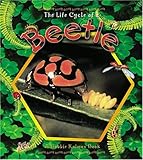Lesson 2: Appositives
Lesson Plan
The Life Cycle of a Beetle

- Learning Goal
- Use appositives to determine the meaning of an unknown word.
- Duration
- Approximately 50 minutes
- Necessary Materials
- Provided: Independent Practice Worksheet
Not Provided: The Life Cycle of a Beetle by Bobbie Kalman
-
Teacher Modeling

will explain that another strategy that is helpful in determining the meaning of new vocabulary words is to read on and look for appositives. An appositive is when the author defines the vocabulary word within the sentence. I will read the section, “Bunches of beetles” (pages 4–5) in The Life Cycle of a Beetle by Bobbie Kalman. I will model how to read on after the bold word, “species” and find the appositive (types) right after the word “species.” I will explain that this is another strategy used by authors to help the reader understand new vocabulary, especially in nonfiction texts and passages.
-
Think Check
Ask: How did I determine the meaning of unknown words? Students should respond that you read the sentence and looked for appositives that gave the meaning of the word.
-
Guided Practice

will read the section, “What is a life cycle?” (pages 8–9 in The Life Cycle of a Beetle by Bobbie Kalman) and use the strategy of reading on to find the appositive to help us understand new vocabulary words. We will discuss the strategy we used to determine the meaning of each bold word in this section.
-
Independent Practice

will read the section, “The cycle begins” (pages 10–11 in The Life Cycle of a Beetle by Bobbie Kalman) and use the strategy of reading on to find the appositive to determine the meaning of the bold words. You will write the meaning of each bold word and explain how you determined its meaning on the Independent Practice worksheet. (Student Independent Practice is provided below in Teacher and Student Materials.) Note: You will have to provide students with pages 10–11 of The Life Cycle of a Beetle so that they can read the pages and use them with the Independent Practice worksheet.
Texts & Materials
Standards Alignment
(To see all of the ReadWorks lessons aligned to your standards, click here.)


great section will use with virtual classroom like google class
great lesson